|
-JAWA MINOR II – AERO MINOR |
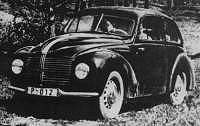 The automobile
Jawa Minor II was likewise prepared during the war. It was presented in public
by autumn in 1945. Production was started in 1946. The engine - two stroke,
two cylinder liquid cooled with engine capacity 615 cm3, capacity 14,7 W (20
PS) at 3500 revolutions per minute, compression ratio 6:1. The engine drived
on front wheels by the front axle. Jawa Minor was equipmented by carburetor
brand mark Solex 30 AHR, electric starter, magneto-battery ignition, single
plate dry clutch and four-speed overdrive transmission. The front wheels was
suspended by springs with hydraulic telescopic shock absorber, behind with lever
shock absorber.
The automobile
Jawa Minor II was likewise prepared during the war. It was presented in public
by autumn in 1945. Production was started in 1946. The engine - two stroke,
two cylinder liquid cooled with engine capacity 615 cm3, capacity 14,7 W (20
PS) at 3500 revolutions per minute, compression ratio 6:1. The engine drived
on front wheels by the front axle. Jawa Minor was equipmented by carburetor
brand mark Solex 30 AHR, electric starter, magneto-battery ignition, single
plate dry clutch and four-speed overdrive transmission. The front wheels was
suspended by springs with hydraulic telescopic shock absorber, behind with lever
shock absorber.
Furthermore the car had hydraulic brakes and rack-and-pinion steering. Engine
fuel - gasoline, mixing rate 30:1. Lenght 4000 mm, height 1485 mm and terrain
clearance 175 mm. The wheels was equipmented by tires 4.75 (5.00) - 16. Curb
mass 690 kg, maximum speed 90 km/hour, fuel consumption 7,5 - 8,5 liters per
100 km. Four seater car with streamlined body, coupe in low-end vehicle.
The new
type was put to fabrication in 1946. New car, for the present designated Jawa
Minor II, took over new floated Air Factory (national enterprise), associating
pre-war auto factories Aero, Praga, Walter and others. In the those days was
changed car type designation to Aero Minor. Its motorcar chassis was manufactured
in the factory Walter in Jinonice, automobile body in factory Rudý Letov in
Letňany, which also completed the cars.
Ing.
Vykoukal with dr. Frey took a journey with one of the first made Minors to France
and Great Britain already in 1946. Known motor-vehicle constructors Claveau
and Grégoire and also representatives of auto factory Mathis and Panhard proved
new car in France. They didn´t lavish commendation and also comparing with new
Renault 4 CV, which later based post war fame of its trademark, talked on behalf
czechoslovak product, which touched French competition for driveability and
exceled at comfort and spaciousity. Minor was very good evaluationed also in
Great Britain and very bargain proposal offered to czechoslovak foreign trade,
but it wasn´t improved. French producers wanted to import engines and transmissions
from Czechoslovakia and outfited them to their own cars. Known British motor-cycle
factory BSA, which once produced also two-track vehicles, was about to produce
the Minor in licence. By the czechoslovak party fault no one of theese transactions
wasn´t realised, although ing. Vykoukal already dealed with development of alternate
four-stroke engine, about which also approved the concern BSA.
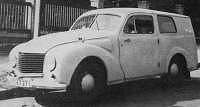 The Minor was distributed with travel automobile
body "tudor" and like a closed auto carrier run Normandia (STW) in
limited series, was distributed like a wagon nad pick-up too. Also was produced
a few two-seated car Roadster. Produced quantity of these modifications was
however imponderable. The factory also exported itself chassis, only with front
fender, front lid and windscreen. The foreing body manufactures constructed
their own auto body on the imported auto components.
The Minor was distributed with travel automobile
body "tudor" and like a closed auto carrier run Normandia (STW) in
limited series, was distributed like a wagon nad pick-up too. Also was produced
a few two-seated car Roadster. Produced quantity of these modifications was
however imponderable. The factory also exported itself chassis, only with front
fender, front lid and windscreen. The foreing body manufactures constructed
their own auto body on the imported auto components.
 The most of
exported cars directed to Holland where was founded strong club of owners very
soon and couple of Minors are going in Holland up to this day. The others Minors
was exported to Belgium, Austria, Switzerland, France, Sweden and anothers North
states, but also to oversea, especially to South America. To 23 states altogether
was exported over 50% produced cars, hereat interest substancially exceeded
productive possibilities. Very interesting is a fact, that Minor was the most
expensive car in its class without exception and its price reached the same
price level, which was usual for cars with capacity about 1000 m3. The similar
price level was on inland market. The air factory wasn´t literally auto factory
and in addition to first rate material and processing gave as well to the chaplet
to this car high factory price, which was influenced by production rates, which
never exceeded 4000 car per one year. This factory price necessarily influenced
the sale price.
The most of
exported cars directed to Holland where was founded strong club of owners very
soon and couple of Minors are going in Holland up to this day. The others Minors
was exported to Belgium, Austria, Switzerland, France, Sweden and anothers North
states, but also to oversea, especially to South America. To 23 states altogether
was exported over 50% produced cars, hereat interest substancially exceeded
productive possibilities. Very interesting is a fact, that Minor was the most
expensive car in its class without exception and its price reached the same
price level, which was usual for cars with capacity about 1000 m3. The similar
price level was on inland market. The air factory wasn´t literally auto factory
and in addition to first rate material and processing gave as well to the chaplet
to this car high factory price, which was influenced by production rates, which
never exceeded 4000 car per one year. This factory price necessarily influenced
the sale price.
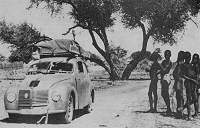 The series
of admirable sport scores and convincing advertising campaigns redounded to
popularity of Minor. One car engaged the promotion driving on Nusle´s stairs.
Another car, type STW, took a drive on the top of Snezka mountain in the full
cast, hereat it gave a incidental proof of its resistance, because when this
car reversed under the top of the mountain on the body roof because of false
move, the carcrew only turned it back on the wheels and carried on without problems.
The Holland importer of Minors hitched the car by splash-board on autocrane
with the view of documenting the strenght of auto body. The auto body didn´t
embody marks of damage. Known roadster F. A. Elstner drived with Minor from
Prague to Coton in Guinea Bay. On the return journey he recorded a record -
daily average 426 km at cross The Sahara, on the land without roads. This record
offered ressistance for long years. Another couple went through a journey behind
The Polar Circle in winter season and in framework of this journey Minor took
a drive in deep snow to the spring-board of known winter center Hollmenkollen,
during the exhibition drive.
The series
of admirable sport scores and convincing advertising campaigns redounded to
popularity of Minor. One car engaged the promotion driving on Nusle´s stairs.
Another car, type STW, took a drive on the top of Snezka mountain in the full
cast, hereat it gave a incidental proof of its resistance, because when this
car reversed under the top of the mountain on the body roof because of false
move, the carcrew only turned it back on the wheels and carried on without problems.
The Holland importer of Minors hitched the car by splash-board on autocrane
with the view of documenting the strenght of auto body. The auto body didn´t
embody marks of damage. Known roadster F. A. Elstner drived with Minor from
Prague to Coton in Guinea Bay. On the return journey he recorded a record -
daily average 426 km at cross The Sahara, on the land without roads. This record
offered ressistance for long years. Another couple went through a journey behind
The Polar Circle in winter season and in framework of this journey Minor took
a drive in deep snow to the spring-board of known winter center Hollmenkollen,
during the exhibition drive.
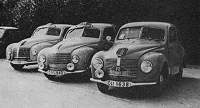 The prewar
racer of Walter factory, Ivan Hodac, took the 1st place in its class and in
the total classification too with his Minor in the known motor racing Raid Polski
in 1948. the Minor´s team took the first place in competition of teams, before
the Skoda factory team. Leopold Lancman took the 2nd place in Rallye Monte Carlo
in 1949, in the category up to 750 cm3 and other racers took the 5., 6. and
9 places also with Minors. The crew Hodac-Versini reached the more success,
when they put the Minor to the finish on the 1st place in its class and the
17th in total classification in the 12th Alpine Rallye in 1949. These cars celebrated
same successes on the motor racing circuits. They gained victory regularly in
Brno. The mass-produced car, registrated by Helaers company, gained victory
in 24hours race in Belgian Spa-Francorchamps in 1948. The crew André-Delhaes
repeated this victory one year later with hour average 80,5 km per hour.
The prewar
racer of Walter factory, Ivan Hodac, took the 1st place in its class and in
the total classification too with his Minor in the known motor racing Raid Polski
in 1948. the Minor´s team took the first place in competition of teams, before
the Skoda factory team. Leopold Lancman took the 2nd place in Rallye Monte Carlo
in 1949, in the category up to 750 cm3 and other racers took the 5., 6. and
9 places also with Minors. The crew Hodac-Versini reached the more success,
when they put the Minor to the finish on the 1st place in its class and the
17th in total classification in the 12th Alpine Rallye in 1949. These cars celebrated
same successes on the motor racing circuits. They gained victory regularly in
Brno. The mass-produced car, registrated by Helaers company, gained victory
in 24hours race in Belgian Spa-Francorchamps in 1948. The crew André-Delhaes
repeated this victory one year later with hour average 80,5 km per hour.
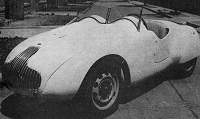 The successes of mass-produced
cars provoked the factory to construction of sports cars. The first one went
out from Jinonice in 1947. Its engine got a special casting of block, which
supported the reboring on 77 mm. The capacity rose on 745 cm3 by stroke 80 mm.
This engine with the carburetor Amal had capacity 23,5 kW (32k). The gearbox
almost wasn´t changed, but the rear transverse spring was replaced by torsion
bar spring. The aluminium ponton body had completely covered back wheels and
front passenger place. The original colour was yellow, the maximum speed was
around 140 km per hour. I. Hodac was the first one, who rode with this car and
he reached the greatest success with this car, when took the 2nd place his class
in 12-hours race on autodrome Linas - Montlhéry and recorded the new record
in class during one lap. The car was produced only in one specimen and didn´t
come down to these days.
The successes of mass-produced
cars provoked the factory to construction of sports cars. The first one went
out from Jinonice in 1947. Its engine got a special casting of block, which
supported the reboring on 77 mm. The capacity rose on 745 cm3 by stroke 80 mm.
This engine with the carburetor Amal had capacity 23,5 kW (32k). The gearbox
almost wasn´t changed, but the rear transverse spring was replaced by torsion
bar spring. The aluminium ponton body had completely covered back wheels and
front passenger place. The original colour was yellow, the maximum speed was
around 140 km per hour. I. Hodac was the first one, who rode with this car and
he reached the greatest success with this car, when took the 2nd place his class
in 12-hours race on autodrome Linas - Montlhéry and recorded the new record
in class during one lap. The car was produced only in one specimen and didn´t
come down to these days.
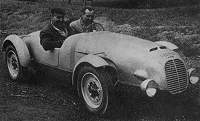 The race
The 24 hours Le Mans was entered on 25th June in 1949 at 16 hrs by attendance
of 185 000 spectatores, 1500 organizers and the flock of 2000 policmen. 49 automobile
makes such as Ferrari, Aston Martin, Rilley, Singer, Healey, Frazer Nash, Talbot,
Delage, Delahaye and others started. The Prench drived strong teams of law-category
cars Renault and Simca, on whose position they mattered. The biggest car in
race was aristocratic Rolls-Bentley with engine capacity 4246 m3. The Czech
primarily wanted to run out. They didn´t started happili. Departure from Prague
was delayed, cargo truck Aero 150, which carried Krattner´s and Sutnar´s car,
couldn´t reach Le mans on time any more. Then the racing car went out by its
own power. It was its first kilometers, because wasn´t time for running-in in
Prague. The second car was waiting in Le Mans, but even this one wasn´t without
problems. The merciless heat cut cars of every automobile makes and new cutout
which improved the coaling occured in bodies.
The race
The 24 hours Le Mans was entered on 25th June in 1949 at 16 hrs by attendance
of 185 000 spectatores, 1500 organizers and the flock of 2000 policmen. 49 automobile
makes such as Ferrari, Aston Martin, Rilley, Singer, Healey, Frazer Nash, Talbot,
Delage, Delahaye and others started. The Prench drived strong teams of law-category
cars Renault and Simca, on whose position they mattered. The biggest car in
race was aristocratic Rolls-Bentley with engine capacity 4246 m3. The Czech
primarily wanted to run out. They didn´t started happili. Departure from Prague
was delayed, cargo truck Aero 150, which carried Krattner´s and Sutnar´s car,
couldn´t reach Le mans on time any more. Then the racing car went out by its
own power. It was its first kilometers, because wasn´t time for running-in in
Prague. The second car was waiting in Le Mans, but even this one wasn´t without
problems. The merciless heat cut cars of every automobile makes and new cutout
which improved the coaling occured in bodies.
Finally
the start! Krattner, who started with plan not tax his car, found out that he
led the whole field in first turning. He rather slowed and let stronger competitors
to overtake him. The rivals droped out step by step because of breaks down and
crashes. Also the second Minor sloped off for a longer time with break down
of transmission in depot. Krattner and Sutnar were on the 7th place in total
classification by capacity coefficient after 18 hours of driving, after 20 hours
they were on the 5th place and they were the 4th in 21st hour of race! The race
was finished by great success of Minors. Krattner and Sutnar took the 1th place
in class and the second in total classification after twelvecylinder car Ferrari.
They drived 2392 km and improved the previous record of the class by 15 km per
hour with average 99,666 km per hour, whereas the winners of the other classes
deeply tailed off behind the record achievements from the last pre-war volume.
This situation was probably promoted by circle condition. The second Minor took
the 13th place in total classification of 19 cars, which finished the race.
The Aero Minor became the only one automobile make, which finished the race
with complement starting cars! Hereat the Minor was very close to become absolute
winner, if it had had more experiences, better working depot, running-in car
and if the victorious crew had been alternated. The alternation became obligatory
in later years. Luigi Chinetti, the later representative of Ferrari in New York,
drived over the 23 hours and Lord Selsdon, much weaker driver, who financed
the car´s start, didn´t drive even solid hour.
The production
of Aero Minor was finished with total quantity of 14 187 (by other sources 14
114) in 1951.

 The automobile
Jawa Minor II was likewise prepared during the war. It was presented in public
by autumn in 1945. Production was started in 1946. The engine - two stroke,
two cylinder liquid cooled with engine capacity 615 cm3, capacity 14,7 W (20
PS) at 3500 revolutions per minute, compression ratio 6:1. The engine drived
on front wheels by the front axle. Jawa Minor was equipmented by carburetor
brand mark Solex 30 AHR, electric starter, magneto-battery ignition, single
plate dry clutch and four-speed overdrive transmission. The front wheels was
suspended by springs with hydraulic telescopic shock absorber, behind with lever
shock absorber.
The automobile
Jawa Minor II was likewise prepared during the war. It was presented in public
by autumn in 1945. Production was started in 1946. The engine - two stroke,
two cylinder liquid cooled with engine capacity 615 cm3, capacity 14,7 W (20
PS) at 3500 revolutions per minute, compression ratio 6:1. The engine drived
on front wheels by the front axle. Jawa Minor was equipmented by carburetor
brand mark Solex 30 AHR, electric starter, magneto-battery ignition, single
plate dry clutch and four-speed overdrive transmission. The front wheels was
suspended by springs with hydraulic telescopic shock absorber, behind with lever
shock absorber. The Minor was distributed with travel automobile
body "tudor" and like a closed auto carrier run Normandia (STW) in
limited series, was distributed like a wagon nad pick-up too. Also was produced
a few two-seated car Roadster. Produced quantity of these modifications was
however imponderable. The factory also exported itself chassis, only with front
fender, front lid and windscreen. The foreing body manufactures constructed
their own auto body on the imported auto components.
The Minor was distributed with travel automobile
body "tudor" and like a closed auto carrier run Normandia (STW) in
limited series, was distributed like a wagon nad pick-up too. Also was produced
a few two-seated car Roadster. Produced quantity of these modifications was
however imponderable. The factory also exported itself chassis, only with front
fender, front lid and windscreen. The foreing body manufactures constructed
their own auto body on the imported auto components. The most of
exported cars directed to Holland where was founded strong club of owners very
soon and couple of Minors are going in Holland up to this day. The others Minors
was exported to Belgium, Austria, Switzerland, France, Sweden and anothers North
states, but also to oversea, especially to South America. To 23 states altogether
was exported over 50% produced cars, hereat interest substancially exceeded
productive possibilities. Very interesting is a fact, that Minor was the most
expensive car in its class without exception and its price reached the same
price level, which was usual for cars with capacity about 1000 m3. The similar
price level was on inland market. The air factory wasn´t literally auto factory
and in addition to first rate material and processing gave as well to the chaplet
to this car high factory price, which was influenced by production rates, which
never exceeded 4000 car per one year. This factory price necessarily influenced
the sale price.
The most of
exported cars directed to Holland where was founded strong club of owners very
soon and couple of Minors are going in Holland up to this day. The others Minors
was exported to Belgium, Austria, Switzerland, France, Sweden and anothers North
states, but also to oversea, especially to South America. To 23 states altogether
was exported over 50% produced cars, hereat interest substancially exceeded
productive possibilities. Very interesting is a fact, that Minor was the most
expensive car in its class without exception and its price reached the same
price level, which was usual for cars with capacity about 1000 m3. The similar
price level was on inland market. The air factory wasn´t literally auto factory
and in addition to first rate material and processing gave as well to the chaplet
to this car high factory price, which was influenced by production rates, which
never exceeded 4000 car per one year. This factory price necessarily influenced
the sale price.
 The series
of admirable sport scores and convincing advertising campaigns redounded to
popularity of Minor. One car engaged the promotion driving on Nusle´s stairs.
Another car, type STW, took a drive on the top of Snezka mountain in the full
cast, hereat it gave a incidental proof of its resistance, because when this
car reversed under the top of the mountain on the body roof because of false
move, the carcrew only turned it back on the wheels and carried on without problems.
The Holland importer of Minors hitched the car by splash-board on autocrane
with the view of documenting the strenght of auto body. The auto body didn´t
embody marks of damage. Known roadster F. A. Elstner drived with Minor from
Prague to Coton in Guinea Bay. On the return journey he recorded a record -
daily average 426 km at cross The Sahara, on the land without roads. This record
offered ressistance for long years. Another couple went through a journey behind
The Polar Circle in winter season and in framework of this journey Minor took
a drive in deep snow to the spring-board of known winter center Hollmenkollen,
during the exhibition drive.
The series
of admirable sport scores and convincing advertising campaigns redounded to
popularity of Minor. One car engaged the promotion driving on Nusle´s stairs.
Another car, type STW, took a drive on the top of Snezka mountain in the full
cast, hereat it gave a incidental proof of its resistance, because when this
car reversed under the top of the mountain on the body roof because of false
move, the carcrew only turned it back on the wheels and carried on without problems.
The Holland importer of Minors hitched the car by splash-board on autocrane
with the view of documenting the strenght of auto body. The auto body didn´t
embody marks of damage. Known roadster F. A. Elstner drived with Minor from
Prague to Coton in Guinea Bay. On the return journey he recorded a record -
daily average 426 km at cross The Sahara, on the land without roads. This record
offered ressistance for long years. Another couple went through a journey behind
The Polar Circle in winter season and in framework of this journey Minor took
a drive in deep snow to the spring-board of known winter center Hollmenkollen,
during the exhibition drive.
 The prewar
racer of Walter factory, Ivan Hodac, took the 1st place in its class and in
the total classification too with his Minor in the known motor racing Raid Polski
in 1948. the Minor´s team took the first place in competition of teams, before
the Skoda factory team. Leopold Lancman took the 2nd place in Rallye Monte Carlo
in 1949, in the category up to 750 cm3 and other racers took the 5., 6. and
9 places also with Minors. The crew Hodac-Versini reached the more success,
when they put the Minor to the finish on the 1st place in its class and the
17th in total classification in the 12th Alpine Rallye in 1949. These cars celebrated
same successes on the motor racing circuits. They gained victory regularly in
Brno. The mass-produced car, registrated by Helaers company, gained victory
in 24hours race in Belgian Spa-Francorchamps in 1948. The crew André-Delhaes
repeated this victory one year later with hour average 80,5 km per hour.
The prewar
racer of Walter factory, Ivan Hodac, took the 1st place in its class and in
the total classification too with his Minor in the known motor racing Raid Polski
in 1948. the Minor´s team took the first place in competition of teams, before
the Skoda factory team. Leopold Lancman took the 2nd place in Rallye Monte Carlo
in 1949, in the category up to 750 cm3 and other racers took the 5., 6. and
9 places also with Minors. The crew Hodac-Versini reached the more success,
when they put the Minor to the finish on the 1st place in its class and the
17th in total classification in the 12th Alpine Rallye in 1949. These cars celebrated
same successes on the motor racing circuits. They gained victory regularly in
Brno. The mass-produced car, registrated by Helaers company, gained victory
in 24hours race in Belgian Spa-Francorchamps in 1948. The crew André-Delhaes
repeated this victory one year later with hour average 80,5 km per hour.
 The successes of mass-produced
cars provoked the factory to construction of sports cars. The first one went
out from Jinonice in 1947. Its engine got a special casting of block, which
supported the reboring on 77 mm. The capacity rose on 745 cm3 by stroke 80 mm.
This engine with the carburetor Amal had capacity 23,5 kW (32k). The gearbox
almost wasn´t changed, but the rear transverse spring was replaced by torsion
bar spring. The aluminium ponton body had completely covered back wheels and
front passenger place. The original colour was yellow, the maximum speed was
around 140 km per hour. I. Hodac was the first one, who rode with this car and
he reached the greatest success with this car, when took the 2nd place his class
in 12-hours race on autodrome Linas - Montlhéry and recorded the new record
in class during one lap. The car was produced only in one specimen and didn´t
come down to these days.
The successes of mass-produced
cars provoked the factory to construction of sports cars. The first one went
out from Jinonice in 1947. Its engine got a special casting of block, which
supported the reboring on 77 mm. The capacity rose on 745 cm3 by stroke 80 mm.
This engine with the carburetor Amal had capacity 23,5 kW (32k). The gearbox
almost wasn´t changed, but the rear transverse spring was replaced by torsion
bar spring. The aluminium ponton body had completely covered back wheels and
front passenger place. The original colour was yellow, the maximum speed was
around 140 km per hour. I. Hodac was the first one, who rode with this car and
he reached the greatest success with this car, when took the 2nd place his class
in 12-hours race on autodrome Linas - Montlhéry and recorded the new record
in class during one lap. The car was produced only in one specimen and didn´t
come down to these days.
 The race
The 24 hours Le Mans was entered on 25th June in 1949 at 16 hrs by attendance
of 185 000 spectatores, 1500 organizers and the flock of 2000 policmen. 49 automobile
makes such as Ferrari, Aston Martin, Rilley, Singer, Healey, Frazer Nash, Talbot,
Delage, Delahaye and others started. The Prench drived strong teams of law-category
cars Renault and Simca, on whose position they mattered. The biggest car in
race was aristocratic Rolls-Bentley with engine capacity 4246 m3. The Czech
primarily wanted to run out. They didn´t started happili. Departure from Prague
was delayed, cargo truck Aero 150, which carried Krattner´s and Sutnar´s car,
couldn´t reach Le mans on time any more. Then the racing car went out by its
own power. It was its first kilometers, because wasn´t time for running-in in
Prague. The second car was waiting in Le Mans, but even this one wasn´t without
problems. The merciless heat cut cars of every automobile makes and new cutout
which improved the coaling occured in bodies.
The race
The 24 hours Le Mans was entered on 25th June in 1949 at 16 hrs by attendance
of 185 000 spectatores, 1500 organizers and the flock of 2000 policmen. 49 automobile
makes such as Ferrari, Aston Martin, Rilley, Singer, Healey, Frazer Nash, Talbot,
Delage, Delahaye and others started. The Prench drived strong teams of law-category
cars Renault and Simca, on whose position they mattered. The biggest car in
race was aristocratic Rolls-Bentley with engine capacity 4246 m3. The Czech
primarily wanted to run out. They didn´t started happili. Departure from Prague
was delayed, cargo truck Aero 150, which carried Krattner´s and Sutnar´s car,
couldn´t reach Le mans on time any more. Then the racing car went out by its
own power. It was its first kilometers, because wasn´t time for running-in in
Prague. The second car was waiting in Le Mans, but even this one wasn´t without
problems. The merciless heat cut cars of every automobile makes and new cutout
which improved the coaling occured in bodies.